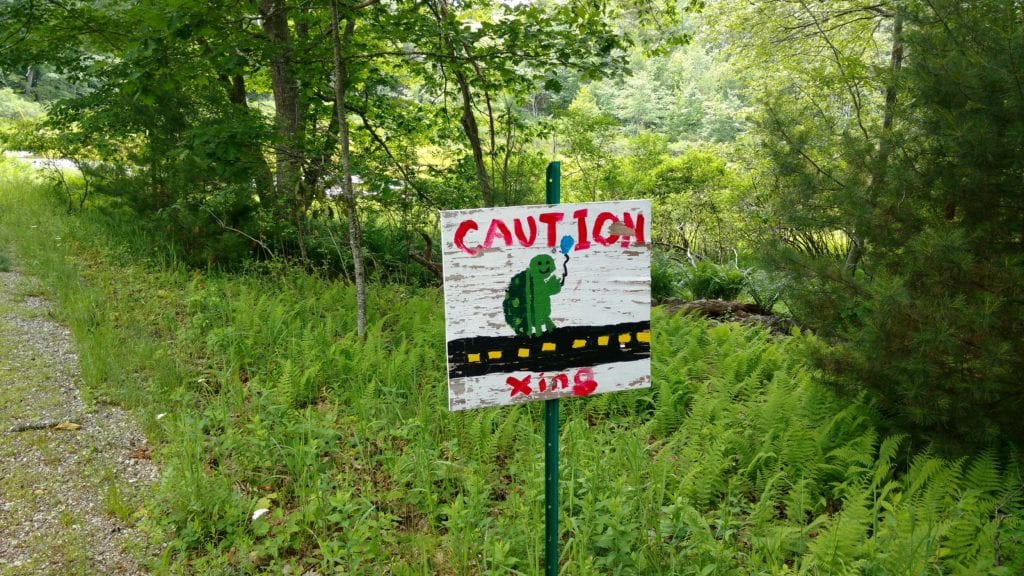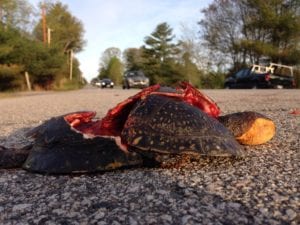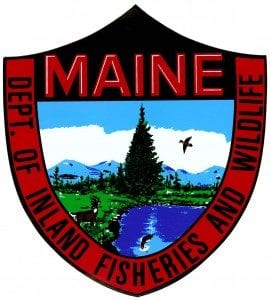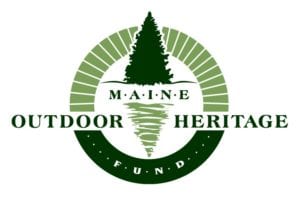
Maine Audubon’s final report for the Maine Turtle Roadkill Survey project is available here (completed February 2021).
While turtles may move slowly, they can travel large distances and often do so every year as they move between habitats. Maine’s turtle species generally overwinter in streams, rivers, marshes, and ponds. As winter turns into spring, they emerge from their wintering sites to bask, forage, and ultimately to breed and nest before returning to their wintering grounds. Those journeys inevitably bring many turtles across roadways.

For slow-moving species like turtles, getting across a roadway alive is a real challenge. And for species that live a long time but don’t reproduce until they’re quite old (Maine’s turtle species reach breeding maturity between 7-18 years of age), losing just a few breeding adults annually can lead to a declining population, or even local extinction.
To help address this problem, beginning in 2018, citizen science volunteers are monitoring roadways around Maine to help identify which species of turtles are crossing where – and which road crossings are most hazardous to Maine’s turtles. Participants in this three-year project are trained in turtle species identification, road safety, and proper data collection methods. They are asked to survey routes that have been identified as sites where turtle crossings may be more likely, and to do so at least three times during the active season (May through September). At the end of this three-year project, results will be used to identify roadway segments where turtle mortality is particularly high, in order to develop mitigation strategies at these and similar sites to reduce or eliminate turtle mortality.
News Center Maine did a feature about this project in April, 2021. Watch the story here:

You can see those observations in real time by visiting the iNaturalist project page where observations are uploaded. In addition to a map of incidences of turtle roadkill, the project includes some (occasionally graphic) images of turtles and other species that did not make it successfully across the road.
Want to learn more? Here are some additional resources:
- Maine Turtle Roadkill Survey Volunteer Guide (2019) (PDF)
- Maine Turtle Species Identification Tips (PDF)
- Maine Outdoor Heritage Fund
- Inland Fisheries & Wildlife’s Rare Turtles page
- Habitat magazine article: “Why Did the Turtle Cross the Road?” (PDF)
- Maine Turtle Roadkill Survey: 2018 Final Results (PDF)
- Turtle Survey Tracking Sheet (XLS)
Interested in getting involved? Please contact us at conserve@maineaudubon.org to sign up for training sessions and surveys.
What to do if you find an injured animal
This project is a partnership between Maine Audubon, Maine Department of Inland Fisheries and Wildlife, the Maine Outdoor Heritage Fund, and MaineDOT. It was funded in part by the Maine Outdoor Heritage Fund, in which proceeds from the sale of a dedicated instant lottery ticket are used to support outdoor recreation and natural resource conservation.



